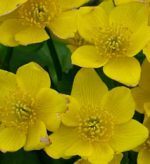 This herbaceous perennial is native to the Northern Hemisphere from Canada to the Carolinas and westward where it is found growing in swamps, marshes, stream edges, and other wet areas. A member of the buttercup family, Ranunculaceae, marsh marigold is not a true marigold or even in the same family. It likes full sun to part shade and wet boggy soil so is useful as a plant for the wettest part of a rain garden and also does well on the edge of ponds or streams, and in bog and water gardens.
This herbaceous perennial is native to the Northern Hemisphere from Canada to the Carolinas and westward where it is found growing in swamps, marshes, stream edges, and other wet areas. A member of the buttercup family, Ranunculaceae, marsh marigold is not a true marigold or even in the same family. It likes full sun to part shade and wet boggy soil so is useful as a plant for the wettest part of a rain garden and also does well on the edge of ponds or streams, and in bog and water gardens.
Description: Growing 1-2’ tall, plants form a mound of large, glossy, heart-shaped leaves on long stalks together with hollow branching stems that bear smaller leaves and clusters of flowers. The bright yellow flowers are 1-2″ across, appear in the spring, and resemble those of the common buttercup. They are made up of 5-9 waxy sepals that look like petals, and numerous conspicuous stamens surrounding a central bundle of carpels. Each carpel produces numerous seeds that are attractive to birds and small rodents.
Poisonous Properties: The toxic substance in marsh marigold is due to the innocuous glycoside ranunculin that breaks down by enzymatic action caused by injury or bruising of the plant tissue to form the aglycone, protoanemonin. The sap, flowers, seeds, and leaves all contain protoanemonin with the greatest concentration being in vigorous growth shoots. Symptoms include itching, rashes, or blistering of the skin, irritation of mucous membranes, nausea, vomiting, bloody diarrhea,dizziness, bloody urine, spasms, fainting, jaundice, paralysis, and convulsions. Drying and cooking detoxifies the poison. The strong acrid taste of the plant usually deters consumption so fatalities are rare.